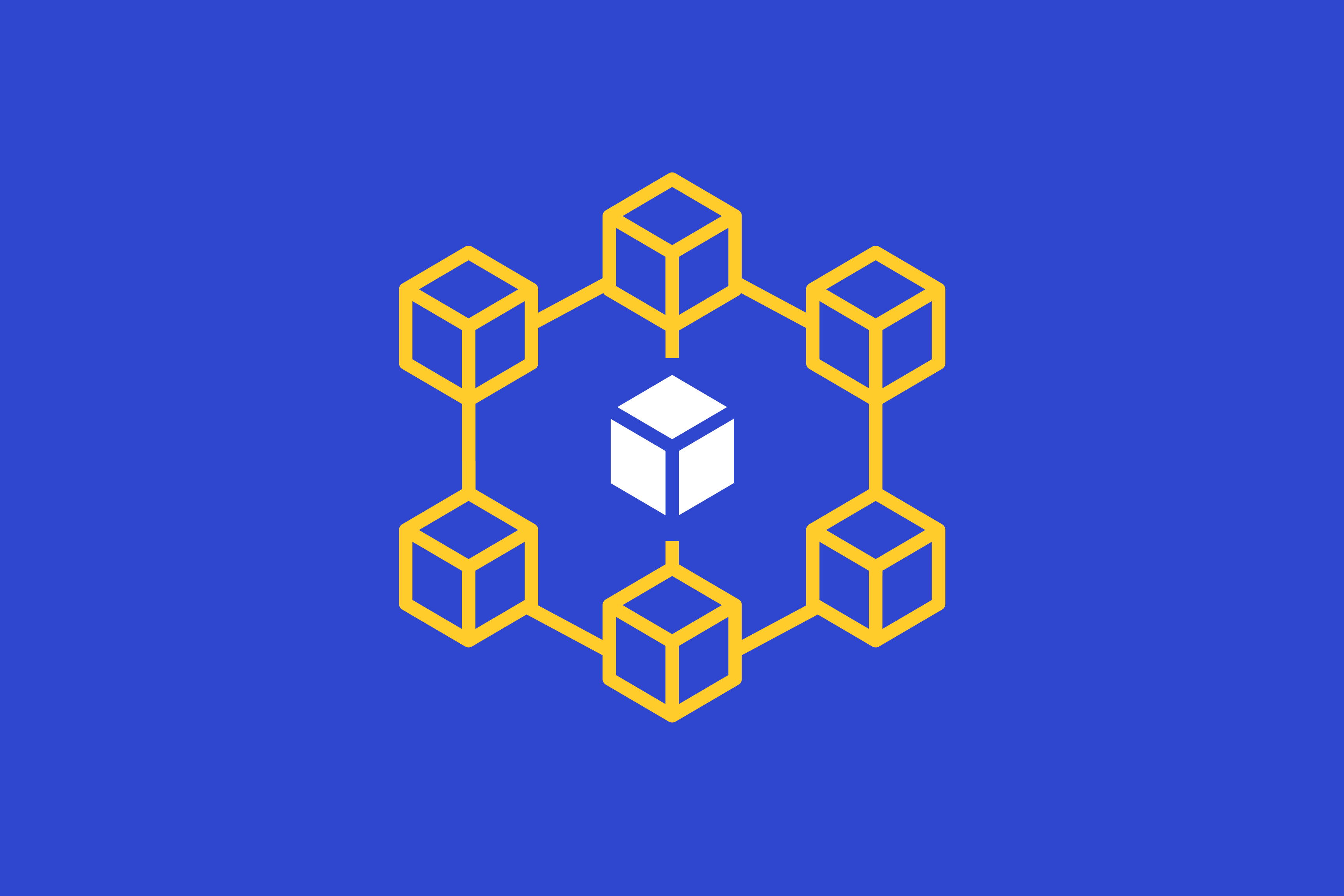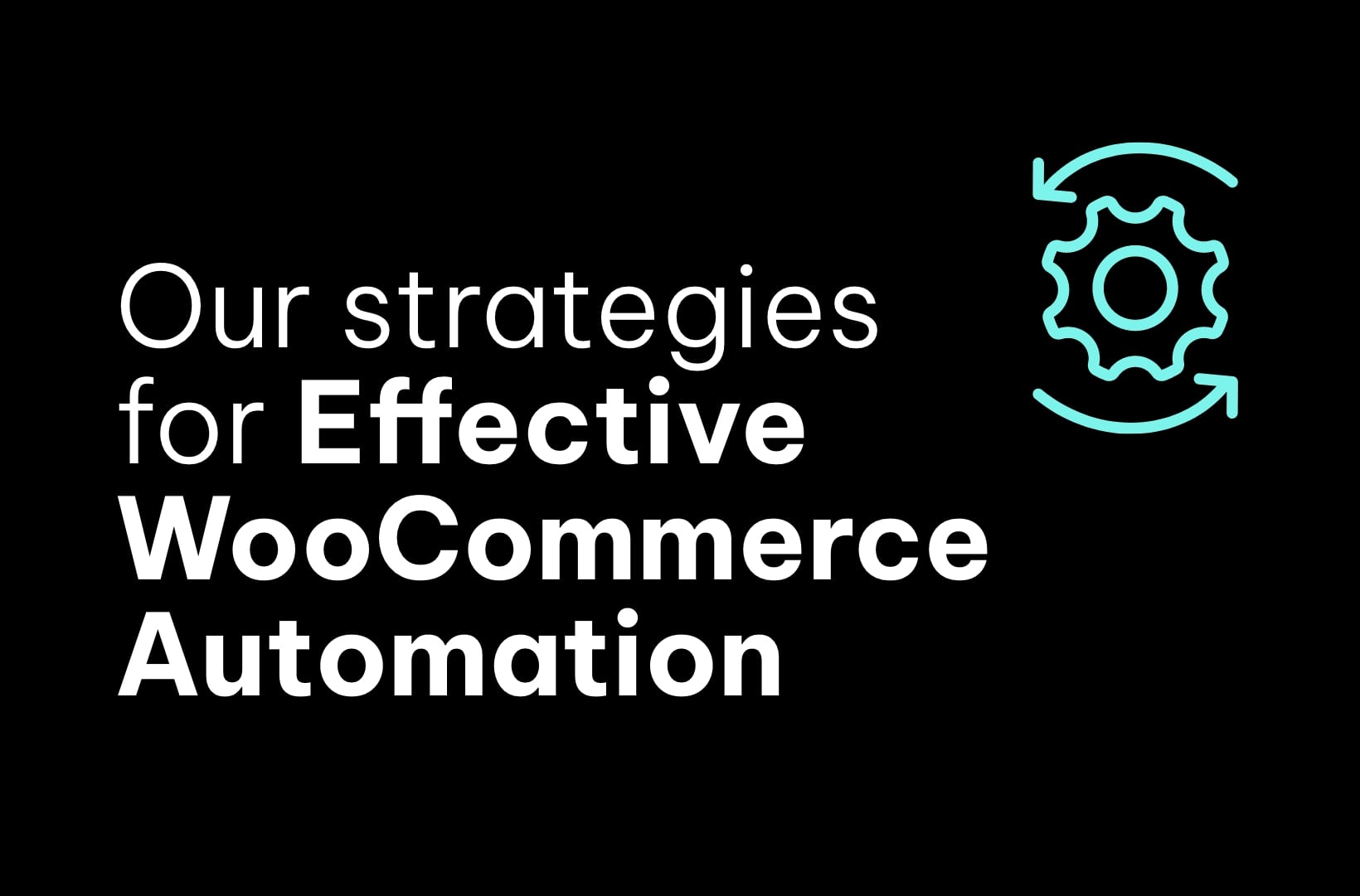In an age where the internet is experiencing a paradigm shift, the term “Web3” seems to ricochet through the corridors of tech forums, crypto spaces, and indeed, the general ethos of how we think about the internet’s future.
Web3 is not just a passing buzzword – it represents a tectonic shift in the way we interact, transact, and even exist online. But how does this transformative wave touch the shores of WordPress, the content management system (CMS) that powers over 43.1% of the web? Can WordPress, a pioneer in the Web2 era, play a pivotal role in this next evolutionary phase?
You’re in the right place to explore these intriguing intersections. In this article, we aim to explore the synergy between WordPress and Web3 technologies. As a website owner, developer, or content professional with a keen interest in the decentralized landscape, you’ll discover how the WordPress ecosystem is already embracing the Web3 revolution.
Beyond the buzz and speculation, we’ll delve into practical pathways for leveraging Web3 technologies in your WordPress site or WooCommerce store. Whether you’re an online merchant eyeing the NFT craze or interested in incorporating cryptocurrency payments into your eCommerce operations, this article will provide actionable insights!
Understanding Web3
Web3 refers to a new generation of the internet that envisions a more decentralized, user-centric, and open online ecosystem. It’s a shift from the centralized model of the internet, Web2, to a more distributed and user-controlled model.
To fully grasp the significance of Web3, let’s take a brief journey through the evolution of the internet.
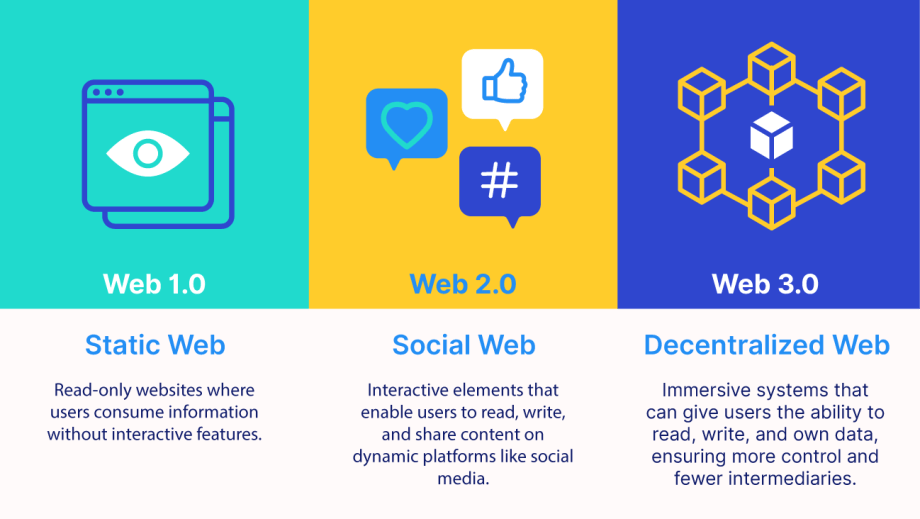
Web1
The dawn of the internet, or Web1, was a fairly simple time. Termed the “Static Web” or “Read-Only Web”, this era was characterized by static websites containing text and images, offering limited bells and whistles, like MySpace and LiveJournal.
Websites were essentially digital brochures with one-way communication – great for basic information dissemination but offering little room for engagement or user participation.
Web2
Fast forward to the Web2 era, a phase often dubbed as the “Social Web” or the “Read-Write Web”. This was a quantum leap from Web1, introducing dynamic and interactive elements. Suddenly, the internet was not just a space for passive consumption but also a centralized space for creation and interaction.
This transformative shift enabled the rise of social media giants like Facebook and Twitter, content-sharing platforms like YouTube, and collaborative tools like the Google Suite. Users could now generate their own content, share it, and collaborate in real time, contributing to a rich, multifaceted digital tapestry and transforming the way we interact online.
Web3
Now, we’re on the cusp of Web3, an era that goes beyond reading and writing content to add a third pillar – ownership. Characterized by decentralized web pages that are created and maintained by users, Web3 will empower users to interact with these pages in a variety of ways, such as via Virtual Reality (VR) and Artificial Intelligence (AI).
Imagine not just posting a picture on a social platform but owning the digital asset behind it. Think of not just purchasing a service with currency but being a stakeholder in a decentralized economy that governs that service.
Web3 promises to put the user back in control.
This means that in addition to consuming and creating content, users will have greater ownership and control over their data, digital assets, and interactions. Users can own digital assets, participate in decentralized economies, and engage in peer-to-peer interactions without relying on intermediaries. It’s a significant leap forward, carrying with it the potential to reshape the internet landscape once again.
If you’re involved in the content creation or management of WordPress websites, understanding Web3 is not just an intellectual exercise but a practical necessity. As we’ll explore in the subsequent sections, WordPress is uniquely positioned to be a significant player in the Web3 revolution.
The platform that democratized content creation during the Web2 era has the foundational elements to take the lead in democratizing digital ownership and user-centric innovations in the Web3 era. From blockchain-enabled plugins to decentralized identity management, the possibilities for WordPress to integrate and innovate with Web3 technologies are endless.
Key characteristics of Web3
The revolutionary promise of Web3 doesn’t stop at its ideological stance of decentralization; it extends to the very technologies and mechanisms that enable this new era of the web. If you’re venturing into the integration of Web3 functionalities within WordPress, understanding these core characteristics of a decentralized, user-centric internet is critical.
The utilization of blockchain technology
Blockchain is a distributed ledger technology that allows data to be stored across a network of nodes rather than on a central server. This decentralized nature is a fundamental characteristic of Web 3.0. Instead of relying on a few powerful central authorities (such as big tech companies or governments), services and applications can operate on decentralized networks of nodes, making them more resistant to censorship, tampering, and single points of failure.
Blockchains use cryptographic techniques to secure data and transactions. This high level of security and trust makes it possible for users to interact directly with applications and services without the need for intermediaries.
With blockchain-based systems, users can grant or revoke access to their data, ensuring that they maintain ownership and decide who can use their information.
Blockchain and distributed ledger technologies provide a transparent and tamper-resistant method of recording and verifying transactions. This enables the creation of decentralized applications (dApps) and smart contracts.
Think of smart contracts as self-executing agreements where the terms and conditions are hard-coded, triggering predefined actions when specific conditions are met. For example, a smart contract could automatically transfer ownership of a digital asset upon payment confirmation.
Decentralized Applications (dApps)
These applications run on a blockchain network and aim to eliminate intermediaries, increase transparency, and give users more control over their data and interactions. They utilize smart contracts; self-executing code scripts that automatically execute predefined actions when certain conditions are met.
dApps are designed to run on decentralized networks, typically blockchain platforms like Ethereum, EOS, or Polkadot. This decentralization means that there is no single point of control or failure. Instead, the application’s code and data are distributed across a network of nodes, often maintained by a community of users or validators.
Many dApps are open-source, allowing anyone to review and contribute to their codebase. This openness fosters collaboration, transparency, and innovation within the dApp ecosystem.
In addition, dApps use consensus mechanisms such as Proof of Work and Proof of Stake to achieve agreement on the state of the network and validate transactions without relying on a central authority.
Some of the use cases where dApps play a crucial role include:
- Decentralized Finance (DeFi): Decentralized finance refers to a rapidly growing ecosystem of financial applications and services built on blockchain technology, aiming to recreate traditional financial instruments and services – be it lending, borrowing, trading, or investing – in a decentralized and permissionless manner. In simple terms, you could borrow money or earn interest without ever going through a bank, all enabled by smart contracts and dApps.
- NFTs: Non-Fungible Tokens (NFTs) are unique digital assets that have gained popularity through dApps, allowing artists, creators, and collectors to buy, sell, and trade digital art and collectibles.
- Gaming: dApps are used in blockchain-based gaming, where players can own, trade, and sell in-game assets as NFTs. This provides true ownership of digital items.
- Supply chain: dApps can improve supply chain management by tracking and verifying the provenance of goods using blockchain technology.
- Identity and voting: dApps can offer secure identity management and voting systems, enhancing privacy and security in these critical areas.
Tokens and cryptocurrencies
The Web3 ecosystem heavily employs tokens and cryptocurrencies, digital assets that can signify a range of values or access within a particular blockchain network.
From governance tokens that allow you to participate in organizational decisions to utility tokens that give you access to specific services, these digital assets are integral to the new decentralized economic models.
Digital identity and privacy
One of the pillars of Web3 is enhanced user privacy and control over personal data. Unlike Web2, where your data often resides in the hands of centralized corporations, Web3 aims for a model where users have secure and portable digital identities. You’ll have the freedom to interact with various services without compromising your personal information repeatedly.
In Web 3.0, there is a push towards self-sovereign identity (SSI), which means individuals have full control over their digital identities. Users can create, manage, and share their identities without relying on centralized authorities, such as social media platforms or government agencies.
SSI relies on blockchain technology to provide secure, tamper-proof records of identity and allows users to selectively disclose only the information necessary for a particular transaction or interaction.
Decentralized Identifiers (DIDs) are a core component of SSI and Web 3.0. They are unique, persistent, and cryptographically verifiable identifiers that are not tied to any centralized registry.
Users can create DIDs and associate them with their personal information, and these DIDs can be used across various applications and services. DIDs provide a foundation for secure and privacy-preserving interactions online.
Privacy-enhancing technologies, such as zero-knowledge proofs, homomorphic encryption, and secure multi-party computation, are being integrated into Web 3.0 to protect user data. These technologies enable data to be used for computations and services without revealing the underlying raw data to the parties involved.
Interoperability and open standards
Web3 isn’t just about isolated blockchain networks; it aims for a more integrated, interoperable web where different blockchains and dApps can communicate seamlessly. Open protocols and standards are highly encouraged, leading to a much more connected and open ecosystem. This promotes the development and adoption of processes that facilitate communication and interaction between different components of the decentralized web.
Imagine an organization where decisions are made collectively, without a hierarchical structure – that’s a Decentralized Autonomous Organization (DAO). DAOs function through smart contracts and allow a decentralized group of individuals to make consensus-based decisions. DAOs are particularly useful in governance and collaborative decision-making models, often facilitated through token-based voting systems.
Web 3.0 places a strong emphasis on semantic understanding of data, where machines can not only process information but also understand its meaning. Open standards for semantic web technologies, such as RDF (Resource Description Framework) and OWL (Web Ontology Language), facilitate the creation of machine-readable and interoperable data structures that allow for better data integration and context-aware applications.
Open standards are typically developed through a collaborative and community-driven process. This approach encourages innovation from a wide range of contributors and helps prevent the concentration of power in the hands of a few companies or organizations. It also promotes transparency and inclusivity in the development of web technologies.
Interoperability and open standards can reduce vendor lock-in, where users are tied to a specific service or platform. This allows users and businesses to have more flexibility in choosing the tools and services that best suit their needs.
Reduced middlemen
One of the greatest advantages of Web3 is the potential reduction of intermediaries. Whether it’s financial transactions, content creation, or data storage, fewer middlemen often mean more efficient, cost-effective processes.
Web 3.0 includes decentralized exchanges (DEXs) that allow users to trade cryptocurrencies and assets directly with one another. These exchanges use smart contracts to match buyers and sellers, removing the need for traditional centralized exchanges and their associated fees.
Crowdfunding and Fundraising via Initial Coin Offerings (ICOs) and Security Token Offerings (STOs) are examples of crowdfunding mechanisms in Web 3.0 that allow startups and projects to raise capital directly from investors without going through traditional venture capital firms or banks.
Decentralized marketplaces built on blockchain technology allow individuals to buy and sell goods and services directly with each other, removing the need for centralized e-commerce platforms and associated fees.
Content creators can use blockchain-based platforms to distribute and monetize their content directly to consumers, bypassing traditional media companies and advertising intermediaries. This enables creators to have more control and a larger share of their revenue.
Moreover, this decentralized model opens up a world of economic opportunities, such as the monetization of dApps, tokenized assets, and even new ways of content monetization – think of articles locked behind a crypto paywall or token-based access to premium content.
For WordPress users and developers, this is not merely academic; the transition to Web3 offers fertile ground for innovation and new business models. As the technology evolves, integrating these Web3 features into your WordPress site will become not just feasible but potentially as straightforward as installing a plugin.
Controversies and legalities surrounding Web3
While Web3 is an exciting frontier for technological innovation, this wild west of decentralized technologies is still in the process of being tamed by regulations and governance.
Let’s delve into the legal maze that surrounds Web3 technologies, particularly if you’re considering integrating them into your WordPress website.
Regulatory actions: A two-faced coin
Agencies like the U.S. Securities and Exchange Commission (SEC) have actively cracked down on some of the largest crypto trading platforms, such as Binance and Coinbase.
These platforms have been charged with a variety of securities law violations, ranging from offering unregistered assets to not adhering to anti-money laundering regulations. These actions often send shockwaves through the crypto community and affect not only the trading platforms but also developers and users involved in the Web3 ecosystem.
Conversely, regions like the EU, Singapore, and the UK are making strides to create more accommodating frameworks. In the EU, for instance, the Markets in CryptoAssets (MiCA) regulatory framework aims to clarify legal requirements for crypto assets and their underlying blockchain technologies.
Regulatory clarity, while potentially constraining in some respects, provides the industry with much-needed guidelines and could encourage more mainstream adoption.
Media controversies: The case of Reddit’s NFT avatars
While regulatory decisions make headlines, controversies surrounding the use and abuse of Web3 technologies are also becoming increasingly common. Take Reddit’s Non-Fungible Token (NFT) avatars as an example. These unique, blockchain-based digital assets have faced a wave of controversy, including allegations of market manipulation through bot purchases.
Despite the criticism, they have generated upwards of $40 million in sales, which demonstrates the complexity and dual nature of Web3’s public perception. There’s enormous enthusiasm for the financial and creative freedom it offers, but also caution due to the lack of oversight and potential for misuse.
The controversies and legalities surrounding Web3 underscore the need for clear regulations, ethical guidelines, and consumer education. As we continue to navigate the uncharted waters of Web3, these will be crucial factors in ensuring its safe and beneficial use.
The role of WordPress in the rise of Web3
The rise of Web3 presents exciting opportunities for WordPress, a platform that was integral in the rise of Web2.
WordPress introduced a user-friendly and intuitive content management system (CMS) that allowed non-technical users to create, publish, and manage their own websites and blogs. This democratization of online content creation lowered the entry barrier for individuals and small businesses, enabling them to participate in the digital space.
Before WordPress, creating a website was an expensive and complex task that typically required specialized skills. But WordPress changed all of that, ushering in an era where anyone could set up a website and contribute to the digital ecosystem. It wasn’t just a tool; it was an enabler of digital freedom.
As the internet evolves into its next iteration, Web3, the core principles of WordPress – openness, decentralization, and accessibility – are more relevant than ever.
For instance, WordPress, with its WooCommerce plugin, may potentially enable individuals or businesses to run their own eCommerce operations without relying on centralized platforms like Amazon or eBay by allowing the user to accept payments directly to their wallet, bypassing traditional payment processors.
Early signs of adaptation
Although Web3 is still in its infancy, there are unmistakable signs that WordPress is adapting to this new world. Developers are working on plugins that allow website owners to accept cryptocurrencies, integrate smart contracts, or even create and sell NFTs directly through their WordPress sites.
WooCommerce stores are exploring ways to accept crypto payments and sell tokenized assets. New themes are being designed to integrate seamlessly with blockchain-based identities, ensuring a more secure and personalized user experience.
To give a tangible example, plugins like WP Smart Contracts are simplifying the process of deploying smart contracts on your WordPress site, enabling functionalities such as token sales or decentralized voting systems.
This is just the tip of the iceberg; as Web3 technologies mature, expect WordPress to be at the forefront, embracing these technologies to offer more control, ownership, and opportunities to its vast user base.
Experiments with Web3 and WordPress
As the intersection between Web3 and WordPress becomes more vibrant, creators are beginning to push the envelope on what’s possible. They are fusing the robust, user-friendly content management capabilities of WordPress with the decentralized, user-centric framework of Web3.
It’s a space rife with experimentation, and among the pioneers leading the charge is Web3 WP, a project that embodies the unlimited potential of combining these two powerful technologies.
Web3 WP: A trailblazer in the WordPress-Web3 ecosystem
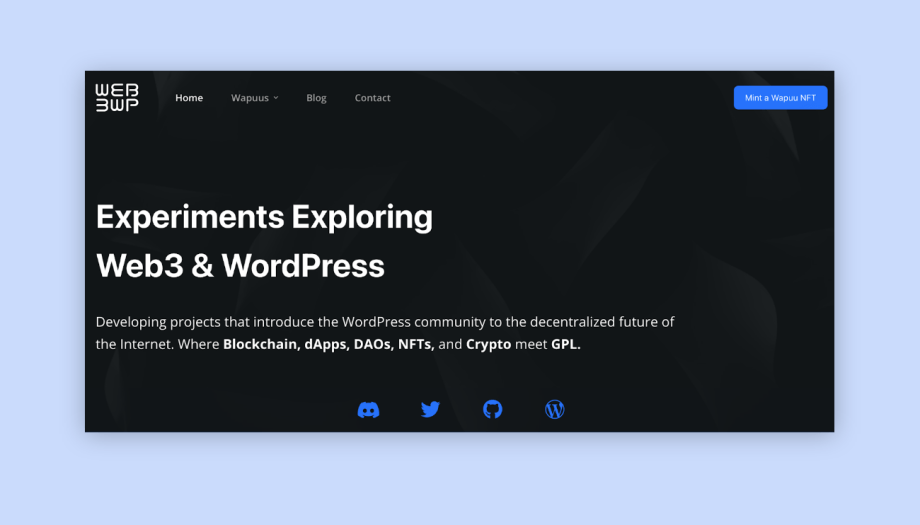
Web3 WP stands as an exemplar of the kind of innovation that’s possible when WordPress and Web3 technologies converge. Their projects demonstrate not only technical feasibility but also the potential to create genuine value and engagement within the WordPress community.
Let’s explore two of their groundbreaking initiatives.
Wapuu NFT collection: Community art meets blockchain
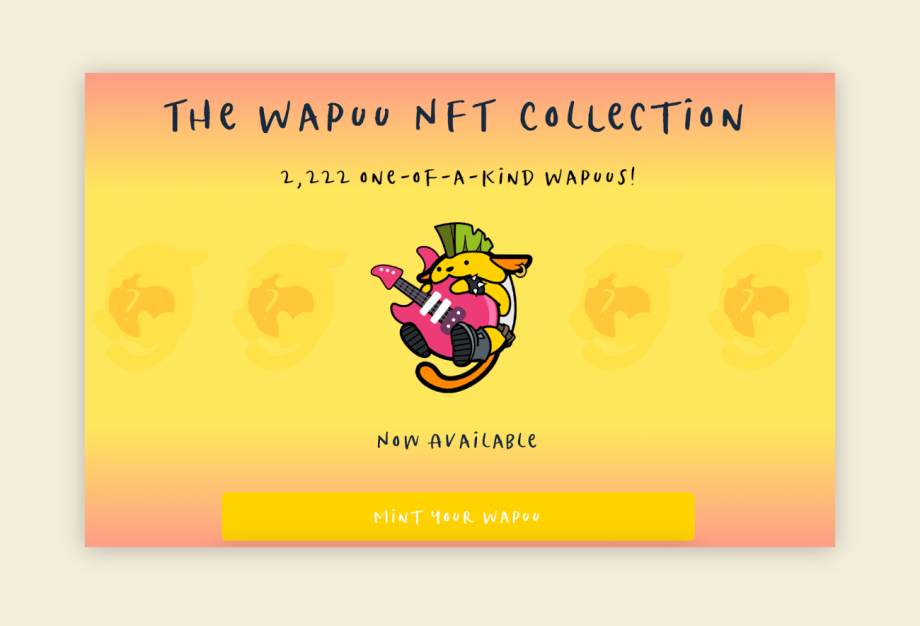
Wapuu, an unofficial but dearly loved mascot of the WordPress community, is at the center of one of Web3 WP’s most captivating projects. Imagine 2,222 uniquely designed Wapuus, each a work of generative art, minted as Non-Fungible Tokens (NFTs) on the Ethereum blockchain.
This isn’t just a high-tech art project; it’s an interactive digital ecosystem where these Wapuus can be collected, traded, or even leveraged for various utilities within the WordPress universe. It empowers the WordPress community to partake in the ownership and exchange of unique digital assets, adding a novel layer of engagement.
The core contributor NFT: Rewarding open-source contribution
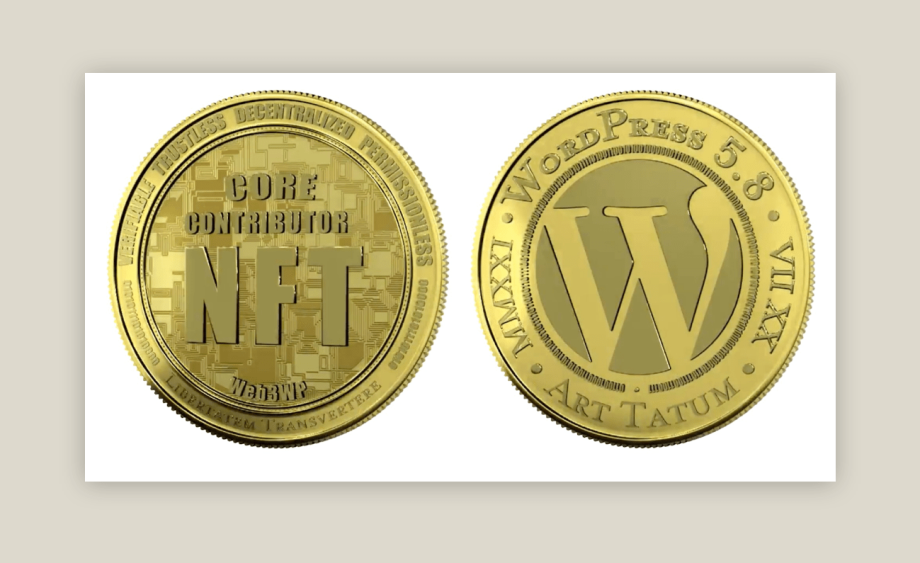
Open-source projects thrive on community contribution, but how do you incentivize this in a meaningful way? Web3 WP’s Core Contributor NFT project tackles this issue head-on.
For each of the 41 major historical releases of WordPress – going all the way back to version 0.7 – Web3 WP has created a limited edition “WordPress Core Contributor” coin.
These digital coins are minted as NFTs and are designed to reward those who have contributed to these significant milestones in WordPress’s history. The aim is to spur more open-source contributions by offering a tangible token of appreciation, something that holds both sentimental and potential monetary value.
Both of these projects from Web3 WP are emblematic of the broader trend: a new frontier is opening up, where WordPress isn’t just a tool for building websites but a platform for enabling decentralized digital experiences and economies.
Whether you’re an artist, a developer, or an open-source enthusiast, these early experiments provide a glimpse into an incredibly promising future. They’re not just ‘cool tech tricks’; they’re pioneering models for what can happen when the philosophies and technologies of WordPress and Web3 converge.
Web3-facing extensions for WordPress
Developers are now creating Web3-facing extensions for WordPress, further bridging the gap between these two technologies. These plugins and extensions offer various functionalities that allow WordPress sites to interact with blockchain networks and embrace the decentralized ethos of Web3.
- NFT Gallery for WordPress: This groundbreaking plugin lets you showcase your NFT collection directly on your WordPress site. Ideal for artists and collectors, it offers a hassle-free way to display NFTs in a visually stunning format.
- Unlock Protocol: Unlock Protocol allows content creators to monetize their WordPress websites through a decentralized paywall. Users can unlock exclusive content using cryptocurrencies, making the monetization process smoother and more inclusive.
- EthPress: Tailored for Ethereum enthusiasts, EthPress allows users to sign in using their Ethereum wallets. It provides the convenience of decentralized login mechanisms while enhancing site security.
- WP Smart Contracts: This plugin makes it incredibly simple to deploy smart contracts directly from your WordPress dashboard. Whether you’re creating a decentralized autonomous organization (DAO) or launching a token sale, WP Smart Contracts streamlines the process.
- CryptoWoo: As its name suggests, this extension integrates cryptocurrency payment methods into WooCommerce stores, giving customers the flexibility to pay in Bitcoin, Litecoin, and other cryptocurrencies.
- Woo Payment Extensions: WooCommerce supports a range of official extensions for cryptocurrency payments, including Coinbase, OpenNode Bitcoin Payments, DePay Payments, and HAYVN Pay. These extensions make it easy for WooCommerce stores to accept crypto payments without any hassle.
Saucal: Your partner in Web3-friendly WordPress development
For large-scale businesses looking to dive deeper into the Web3 world, Saucal stands out as a premier WooCommerce partner. Specializing in crafting solutions that scale your existing website to accommodate Web3 operations, Saucal is well-equipped to handle all aspects of your WordPress website development needs.
Project highlights by Saucal
- ShopX ReserveX integration: Saucal collaborated with ShopX to develop a Woo integration for their product, ReserveX. The outcome is a revolutionary Web3 sales channel that uses token-gating to offer exclusive access to products and perks for loyal customers.

- Boson Protocol partnership: Saucal is working with Boson Protocol, a project that brings the tokenization, transfer, and trade of physical goods into the realm of NFTs. Their collaboration aims to make redeemable NFTs a new standard in eCommerce.
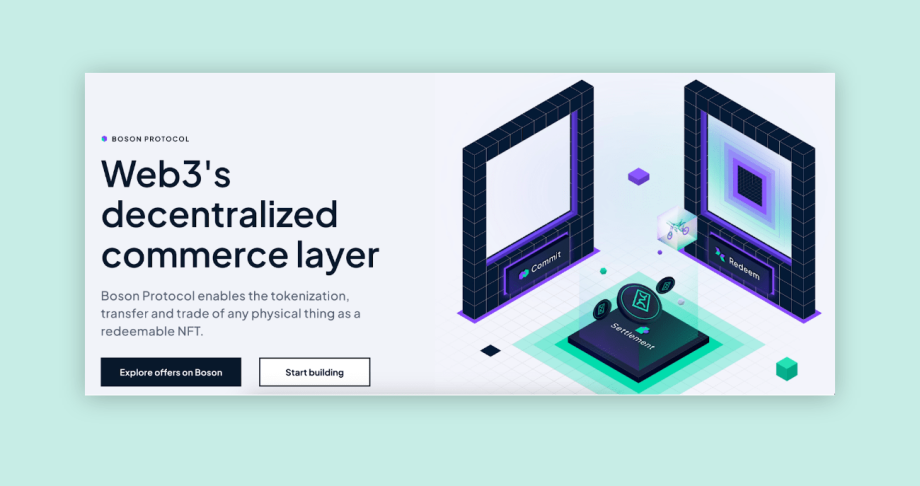
- Merch site with NFTs: Saucal has also assisted in building a merchandise website that offers an NFT with every purchase, adding an extra layer of value and exclusivity for customers.
Here’s why working with WooCommerce experts is so important if you’re planning on embracing the world of Web3, according to Kostas Seresiotis, Senior Product Engineer at Saucal:
Integrating Web3 technologies with WordPress opens a new era of decentralized possibilities. While it can be done, it presents both exciting opportunities and unique challenges that demand careful consideration.
Applications of Web3 and WordPress
In this brave new world of decentralized finance, digital assets, and blockchain-enabled functionalities, your WordPress site can serve as more than just a platform for traditional online presence.
Below are some compelling ways you can integrate Web3 into your WordPress/WooCommerce ecosystem. And remember, if you’re uncertain about how to implement these cutting-edge features, Saucal is always at your service to assist you.
Enabling crypto payments on your Woo store
One of the most straightforward applications is enabling crypto payments on your WooCommerce (Woo) store. Utilizing plugins like CryptoWoo, you can integrate crypto payment gateways that enable your customers to complete transactions using various cryptocurrencies.
This opens up a new dimension of payment flexibility and can attract a tech-savvy customer base that prefers decentralized digital assets.
Registering and logging in with a Web3 wallet on your Woo store
Forget about the days of managing cumbersome passwords. With the integration of Web3 wallets like MetaMask, users can register and log in using their crypto wallets without traditional usernames and passwords.
Instead, they sign transactions with their wallets, enabling decentralized authentication and enhancing privacy. Saucal can help connect your WooCommerce store with the MetaMask app or similar Web3 wallets.
Selling NFTs on your WordPress/Woo site
The booming market for NFTs isn’t just for artists and collectors; it offers untapped potential for WordPress and WooCommerce users too.
With plugins like NFT Gallery for WordPress, you can list, sell, and transfer unique digital assets right from your website. Whether it’s digital art, collectibles, or even exclusive content, NFTs provide a unique avenue for monetization and customer engagement.
Token-gating content on your WordPress site using NFTs
Imagine offering premium content exclusively to a community of dedicated followers. With token-gating, you can grant access to select content to users who own specific NFTs. This not only incentivizes the ownership of your digital assets but also cultivates a sense of exclusivity and loyalty among your audience.
The Unlock Protocol plugin is a straightforward way to implement this feature.
Protecting exclusive merch drops with Web3 token-gating
In the world of merchandise, exclusivity often drives demand. Using Web3 token-gating, you can ensure that only users who possess specific tokens have access to your limited-edition merchandise or early releases. This anti-scalping mechanism maintains the exclusivity of your products while ensuring a fair purchase process.
As these applications continue to evolve, the integration of Web3 into WordPress and WooCommerce is likely to become more commonplace and sophisticated. Whether you’re a pioneer in the space or a business owner looking to upgrade your online offerings, now is the time to seize these decentralized opportunities.
And whenever you need specialized assistance, Saucal is ready to provide tailored solutions to help you navigate this new frontier!
Web3: The future of WordPress?
It’s becoming increasingly clear that the future of WordPress is entwined with the burgeoning landscape of Web3. Although we’re still in the nascent stages of this evolution, the signs are auspicious – WordPress is showing promising adaptability to the decentralized, blockchain-based frameworks that define Web3.
From enabling cryptocurrency payments and Web3 wallet integrations to facilitating the sale of NFTs and token-gating content, the applications of Web3 within the WordPress and WooCommerce ecosystem are already in motion.
For any WooCommerce store owners interested in riding this wave of innovation, Saucal is your go-to consultant. We offer the best-in-class services tailored for this new age, including expert WooCommerce development, custom extensions, managed upkeep services, smooth migration to WooCommerce, and scalability optimization.
Saucal’s expertise doesn’t end with mere integration; we provide a comprehensive suite of solutions aimed at fully leveraging the capabilities of Web3 technologies. This ensures that you are not just keeping up with the times, but are also primed to take advantage of emerging opportunities in this decentralized frontier.
Don’t be a bystander in this transformation – contact us today and explore how you can integrate Web3 functionalities into your WordPress site or WooCommerce store!
